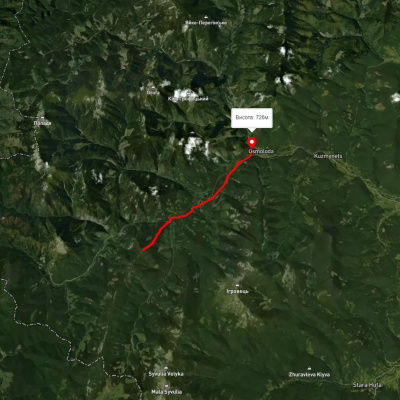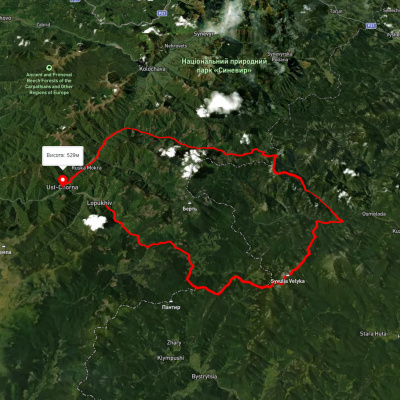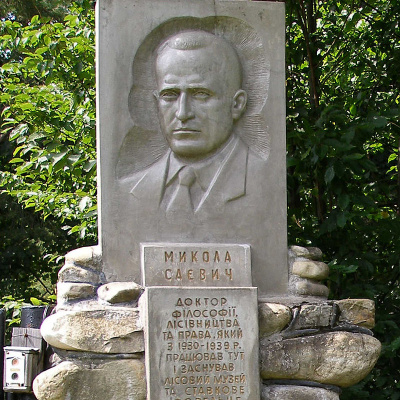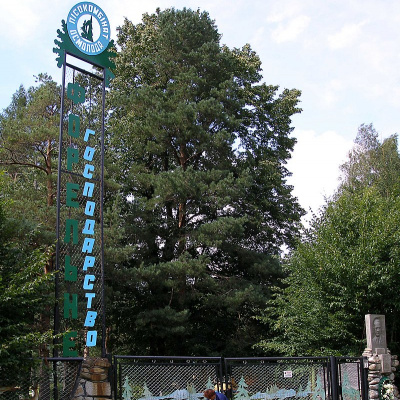Osmoloda is the southernmost village in
the Rozhniativ district of Ivano-Frankivsk region. It is located in the Gorgany massif. In the village's suburbs, the Bystryk and Petros rivers flow into the Limnytsia. It was here that the metropolitan's summer residence-resort with
the Cedar Chamber was founded (early 20th century). It could be reached by the narrow-gauge Broshniv-Osmoloda railroad.
The official date of foundation is 1873. The population is about 60 people. There is not even an elementary school in the village, although there were more children in the Soviet times and the elementary school was functioning. The village of Osmoloda is an ancient settlement of woodcutters, located in the highland valley of the Limnytsia River. The name comes from
Mount Moloda ("Here is Moloda"), not far from which the village is located. The small number of residents (about 60 people) is due to the village's location (practically the end of the road) and the migration of locals abroad. The Rozhniativ district of Ivano-Frankivsk region, to which Osmoloda belongs, is generally the birthplace of Ukrainian emigration. In 1891, residents I. Nebylov, Pylypiv, and V. Ilynyak left their native village in search of a better life and went to Canada, marking the beginning of a flow of thousands of people seeking a better life. The villagers erected a monument to their fellow countrymen.
The Moloda River flows through Osmoloda, which in the 1980s was considered the cleanest river in Europe. Just downstream of the river is the Pidliute tract, where there is a villa called the Cedar Chamber, built in the early 20th century. It is known as a resort and
summer residence of Metropolitan Andrey Sheptytsky. The surrounding lands have long belonged to the Lviv Metropolia of the UGCC and were a place of rest and treatment for Lviv metropolitans, due to the abundance of natural mineral springs rich in hydrogen sulfide. On August 12, 1934, on a Sunday, the cedar reserve was inaugurated, attended by Metropolitan Andrey Sheptytsky, scholars, and numerous guests. A month later, on September 20, 1934, by the decision of the Stanislaviv voivode, the area of European pine in Gorgany was legally recognized as a reserve. A number of objects covering an area of 18 km² were allocated and proposed as reserves: fir, spruce, sycamore, pine, beech, the Stavky tract, which united three high-mountain ponds, separate peat bogs and rock reserves, and the Pidliute tract ("Zhyvets," "Pidliute," and "Palata").
You can see the "Cedar Chamber" on the way to the village, it is clearly visible to the right of the road. On the territory, you can take mineral water directly from the spring.
Now the residence has turned into a monastery of the Basilian Fathers. In Osmoloda itself, there were tartaki (sawmills) that were the property of the metropolis. 10 km from Osmoloda, in the Angeliv tract, there is the
Angeliv blast furnace of 1810, built by Anton Angelovych, who contributed to the creation of an ironworks here: a blast furnace, 12 mines for ore extraction, 2 hamarni (iron processing factories), and a forge for the production of nails were built. The complex operated for only 6 years and was heavily damaged during the First World War. It is not difficult to find this industrial architecture monument - you need to stop at the information board about the blast furnace before reaching Osmoloda, then cross the bridge to the other side of the river, then the path on the left will lead you to the furnace.
The village has several grocery stores, a worker's dormitory and dining room, a trout farm, and is developing green tourism. Osmoloda is an attractive place for hiking: there is access to the ridges and peaks of
Igrovets,
Syvul,
Popadia,
Grofa, and Arshytsi. The trails around Osmoloda are the best cleared and marked. In the Luzhky tract, between the Arshytsia ridge and Mount Kin, Lviv Studite monks partially rebuilt the skete of St. Andrew the First-Called, which was destroyed by the Soviet army during World War II.
Not far from the village there are protected areas: Grofa landscape reserve, Yaykivskyi reserve, Mshana swamp, Liutoshary swamp, Syvulia tract, Lopushna tract, Kotelets tract, Rosokhan Lake natural monument, Limnytsia River landscape reserve.
These places are rarely visited by tourists, due to the poorly developed recreational infrastructure, lack of normal roads, and, accordingly, transportation. But this has its advantages for those who seek a quiet vacation in a quiet place, in nature. The Limnytsia River, a natural monument of national importance, is considered the cleanest river in Europe.
As of July 23, 2014, only Kyivstar has mobile service in the village. In Rozhnyativ district, road workers were repairing the Kalush-Osmoloda highway in an intensive mode to mark the 150th anniversary of the birth of UGCC Metropolitan Andrey Sheptytsky.
- Osmoloda Village Council, 1 Shkilna St. +38 (03474) 2-13-02
- Mountain Search and Rescue Service in the village of Osmoloda +38 (097) 753-74-24, +38 (067) 342-04-98.






